Eugenics/Eugenic Sterilizations in
Indiana
Number of
Victims
Period During Which Sterilizations Occurred
Sterilizations in Indiana officially started in 1907 with the world’s first eugenic sterilization law, but in 1909 a new governor, Thomas Marshall, soon put a stop to the process by threatening the funding of institutions that used the law (Paul 1965, p. 343), and the law was struck down in 1921 by the Indiana Supreme Court. The first sterlization law was struck down by the state supreme court due to violations to the Fourteenth Admentment (Stern 2005, p. 98). A new law was passed in 1927 that cleared any pontential interpation of the law violating the fourteenth amdendment, and was on the books until 1974, though most sterilizations had already stopped by this time (Baldanzi et al.). There were several hundred prelaw sterilizations, taking place between 1899 and 1907, carried out on criminals in the Indiana State Reformatory, all vasectomies done on male prisoners (Paul 1965, p. 342).
Temporal Pattern of Sterilization and Rate of Sterilization
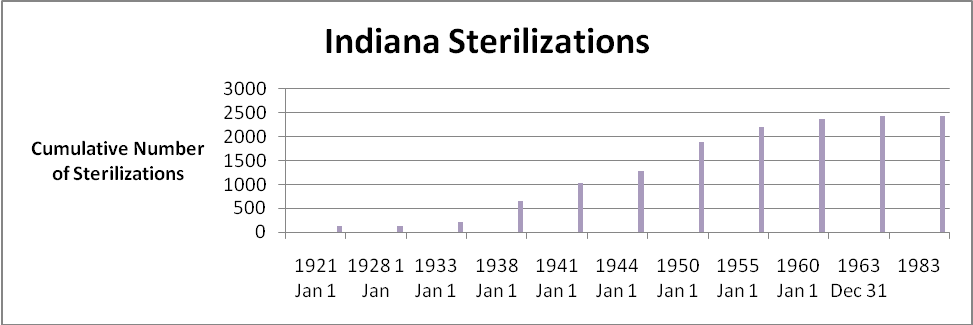
This graph illustrates the changing patterns of
the rate of sterilization in Indiana. In the beginning period
(1907-1930) and at the end (1960-1983) there were few sterilizations,
but during some of the years between (mostly 1933-1950) there was a
large number of sterilizations, with only a mild increase from 1950-60,
after which there were very few. For the period 1933 to 1950, a
total of 1672 sterilizations were performed, which averages to 98
sterilizations per year. The periods with the highest number of
sterilizations were 1933-1938, when 443 people were sterilized, and
1944-1950, with 603 sterilizations. In the 1933-1938 period about
90 people were sterilized per year, and the sterilization rate was
about 3 people sterilized per 100,000 residents per year. The period
1944-1950 had a rate of about 100 sterilizations per year, and the
sterilization rate per resident per year was also about 3
(StatsIndiana).
Passage of
Laws
Groups
Identified in
the Law
The first law, in 1907, targeted: “’confirmed criminals’,
‘idiots’, ‘imbeciles’,
and ‘rapists’” (Stern 2007, p. 9). The
second
law, in 1927, was somewhat more limited, confined to the “’Insane’,
‘feeble
minded’ or ‘epileptic’” (Stern 2007, p.29). There
was thus a shift in emphasis, from the mentally ill
and serious
criminals to only the mentally ill.
Both
laws were specifically designed to target those housed within state
institutions, not those in the general population (Stern 2007, pp. 9,
29).
Process of the Law
The first law stated that state institutions
containing targeted individuals (such as prisons, asylums, or
reformatories), would appoint two surgeons to investigate candidates
for sterilization in those institutions, and if they thought society
would benefit from their not having children, the person would be
sterilized. The second law’s procedure was much less
straightforward, a deliberate change to prevent the law from suffering
the same downfall in the courts as its predecessor. An
institution’s superintendent would suggest a certain person be
sterilized to the institution’s governing board. The board would
issue a notice to the inmate informing him/her of a hearing. This
hearing before the board of the inmate and/or a relative would
determine if the candidate should be sterilized. If the inmate or
his/her family was dissatisfied with the ruling, then they could appeal
to the court system. This law was expanded in 1931 to empower
county judges, with the approval of two physicians, to order the
sterilization of the feebleminded and insane during their commitment
procedure (Stern 2007, pp. 29-30).
Precipitating
Factors
and Processes
Even after the first law was struck down for lack of due process, eugenics itself did not die in Indiana. Better babies contests and eugenics presentations at county and state fairs helped maintain public interest in the ideas of human heredity (Stern 2007, p.22). In 1915 Governor Samuel Ralston created the Committee on Mental Defectives. It worked throughout the period 1915 to 1924 (when there were virtually no sterilizations), doing family studies, assembling pedigrees, and publishing findings to try and keep interest in hereditary defectiveness alive. Findings include the assertion that 2% (Fifty-six thousand persons in all) of Indiana residents were mentally defective, and these defectives could usually be found in isolated and rugged parts of the state, the exact same places where one found the rural poor (Lantzer and Stern 2007, pp. 7-9).
Such findings as this helped to incite C.M.D. member and state senator C. Oliver Holmes to lobby for sterilization to return to Indiana. He attempted to push a new law through in 1925, but this effort eventually failed in the State House of Representatives (Lantzer and Stern 2007, p. 9) Holmes remained undeterred, and received a federal boost for his push for a new law in 1927 when the US Supreme Court decided the Buck v Bell case, supporting involuntary sterilization in Virginia. In Buck v. Bell, the court ruled that the sterilization of Virginia woman Carrie Buck was in the public interest just like vaccination, and as such could be done against the will of the person being operated on. This event was so important in legitimizing sterilization that Lantzer and Stern state that “the resurgence of eugenic sterilization in Indiana could not have taken place without one of the most famous and infamous US Supreme Court decisions, Buck v. Bell” (p. 11).
One factor that led to the increased rates of sterilization seen in the 1930s was the Great Depression. Budgetary constraints pushed institutions such as Fort Wayne to seek ways to parole inmates, and it was felt that inmates would pose less of a threat to the outside world were they unable to have children. Thus, some inmates were sterilized so that they could be let go and not pose a burden on the state treasury (Stern 2007, pp. 30-31).
One other factor that should be mentioned in the popularity of eugenics is the social change that was sweeping Indiana in the early 1900s. What was once an overwhelmingly agricultural and rural state was gradually converting to a more urbanized, educated, scientific, and modern society. As some elements of Indiana’s society progressed, those who failed to do so were more and more obvious in their marginalization. The class differences between those who were investigated and those doing the investigations may have also played a role in the system classifying many of the rural poor “degenerate” (Stern 2007, p. 14; Lantzer and Stern 2007, p. 9).
Groups
Targeted and
Victimized
As seen in the law’s explicit statements, those with various degrees of mental disability were targeted for sterilization, though the rural poor often ended up as targets as well. Poor whites from Kentucky and Tennessee were often singled out as disproportionately degenerate as well, especially those living in the back country (Stern 2007, p. 20). These groups were not only outsiders, but had been left behind by the developmental forces sweeping Indiana in the early 20th century. Their social stagnation could easily be characterized as due to innate inferiority compared to the rest of the state (Stern 2005, p. 13). Another group that was also targeted by Indiana's sterilization laws were the Ishmaels, a local community whom lived in Indiana (Stern 2005, p.15). In Stern's book, its mentioned how Oscar Mcculloch, observes this tribe and concluded they were subhuman, referring them as "devil grass" since they were burdening the state of Indiana due to their way of living (Stern 2005, p. 16). The studies done on the group known as the Tribe of Ishmael by eugenic researchers helped show society why compulsory sterilization regulation was needed for degenerative families to preserve society and rid them of all defective traits (Deutsch 2009, p. 7).
Ishmaelites
The tribe of Ishmael was discovered by Oscar McCulloch, a
minister for a local parish in Indianapolis, in 1876 (Deutsch 2009,
p.26) during the many visits he made to the poor families around
Indianapolis. The family he saw he described as "hardly human beings"
(Deutsch 2009, p. 27). With descriptions like this describing the Tribe
of Ishmael just upon first impressions, it is no wonder that eugenic
researchers saw this family as an ideal case to justify their movement.
The naming for the tribe "Ishmael" by McCulloch had the intent to
depict this poor community group as a threat to civilized society
(Deutsch 2009, p. 5). Intentionally labeling this group with an
Arabic sounding name led some believe that this group Islamic, which
was not true (Deutsch 2009, p. 5). The intentions were to differentiate
the Ishmaels with this name when compared to their "white neighbors"
because McCulloch found a lack of physical differences between these
groups when trying to depict the Ishmaelites to the public (Deutsch
2009, p. 4). As for the composition of the Tribe of Ishmael, from
McCulloch's studies depicted the group as poor whites who degenerated
to become like Gypsies, Muslims and other races (Deutsch 2009, p. 56).
This was essentially making the readers of McCulloch's studies actually
believe that "urban whites" could devolve (Deutsch 2009, p. 7).
Not only did the composition of the group make society in during these
times fearful of degenerative traits but also the behaviors and norms
that were associated with the groups such as the Ishmaelites.
The Ishmaels were composed of individuals and families from freed
or escaped African slaves, Native American tribes and Europeans who had
escaped indentured servitude (Carlson 2011, p. 15). It could be that
form this diverse mix in the group of Ishmaelites unique norms and
behaviors formed, which were seen as taboo by the rest of society.
Ishmaelites wore colorful garments and embraced their norms within
their culture (Deutsch 2009, p. 15). But all these clashed with norms
from the lifestyle of mainstream society from that time (Deutsch 2009,
p. 15). McCulloch depicted this group as a "parasitic race with a
peripatetic lifestyle"(Carlson 2011, p. 16) and also viewed them as
individuals who refused to improve themselves regardless of how much
aide was given to them (Deutsch 2009, p. 7). Essentially believing that
the Ishmaelites were draining society for resources just to survive.
For example, studies done by James Frank Wright such as interviewing an
individual called Kate Thorton (Deutsch p.82). Kate talked about her
husband and mentioned how her husband stole and would often get drunk
(Deutsch 2009, p. 82). Wright believed that
almost every woman from the Ishmael tribe took part in prostitution
(Deutsch 2009, p. 87). Wright also depicts many Ishmaelites as "raging
alcoholics and drug addicts" (Deutsch 2009, p.86). Over the decades
that followed the discovery of the Ishmael tribe, this group became to
symbolize the "undeserving poor" whom were "physically and mentally
degenerative (Deutsch 2009, p. 7).
The studies done by McCulloth and his associates made the Ishmael tribe as their primary evidences against the dangers of the growing epidemic of "feeblemindness" and other social problems (Duestch 2009, p. 7). This group was also used to convince US congress to implement the Immigration Restriction Act of 1924 to protect American Society from "degenerate" wishing to enter the US (Deutsch 2009, p. 7). Traits of the Ishmael tribe mentioned above is what eugenic researchers used to make their case of the requirements for compulsory sterilizations and also help politician in the state of Indiana to pass the 1st sterilization law in the country in order to "protect" humanity from degeneration. In 1933 the tribe of Ishmael and the findings based on this group were presented as examples of the dangers human society faced if individuals with "undesirable traits" were unregulated at the Eugenics exhibit at the Chicago World Fair (Deutsch 2009, p. 168). Pictures and Posters like the one below were used evidence to depict the Ishmaelites as an uncivilized community. Evidence presented at the World Fair depicted the community living style to the research done on family linage and the potential that community member of the Ismael tribe carried various defective traits.
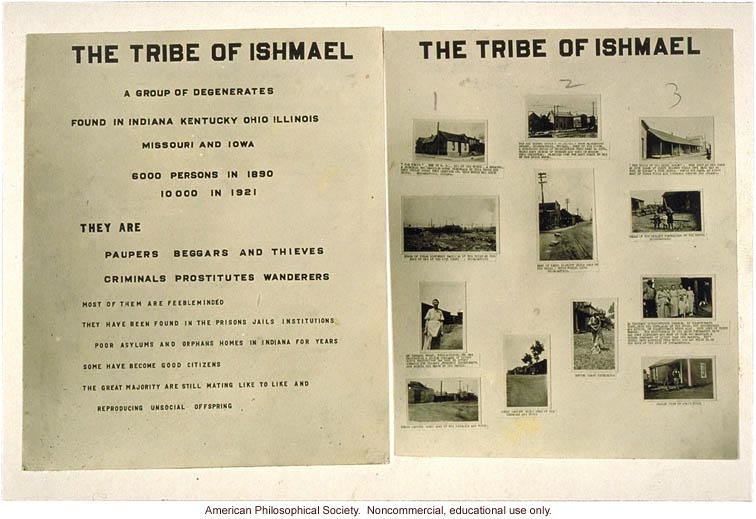 (Photo origin:
http://www.eugenicsarchive.org/html/eugenics/index2.html?tag=713)
(Photo origin:
http://www.eugenicsarchive.org/html/eugenics/index2.html?tag=713)
Other Restrictions Placed on Those Identified in the Law or With Disabilities in General
One of the laws preceding the 1907 sterilization law was a 1905 law that forbade the “mentally deficient”, those with a “transmissible disease”, probably a reference to syphilis, or “habitual drunkards” from marrying (Stern 2007, p. 4).
Major Proponents
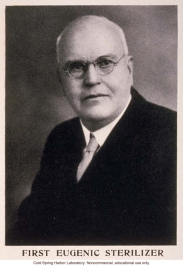 (Photo
origin: Mary Washington College, Department of History and American
Studies; available at http://www.umw.edu/hisa/resources/)
(Photo
origin: Mary Washington College, Department of History and American
Studies; available at http://www.umw.edu/hisa/resources/)
Dr. Harry C. Sharp was a pioneer in the use of vasectomies, originally for the purpose of curing sexual delinquency in inmates at the Indiana State Prison. Interesting enough Dr.Sharp was against castration method, viewing it as a punishment for the individual(Quiroz 2008, p. 27). The reasoning behind this was because Sharp believed that if the individuals were aware of their sterilty, then depression could settle in (Quiroz 2008, p. 27). Sterily in Sharp's mind would only become a punishment if it resulted in the removal of the gentalia or preventing enjoy sexual pleasure (Quiroz 2008, p. 27). He lobbied the Indiana government to use sterilization to cure problems of mental deficiency and sexual deviance in Indiana, helping to get the 1907 law passed. Sharp also attempted to spread his ideas through works such as Vasectomy, a pamphlet that touted his successes performing the operation on prisoners and called for more states to adopt sterilization laws (Stern 2011, p. 11).
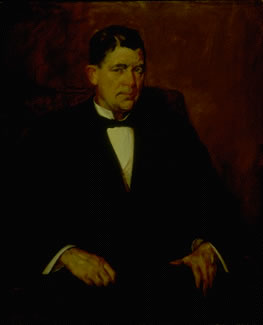
Governor James Frank Hanly was the governor of Indiana, 1905-1909, who signed the 1907 law authorizing involuntary sterilizations in Indiana. Hanly was known for being “an anti-vice crusader and hard-line prohibitionist” (Stern 2005, p. 9), even so much so as to run for president for the Prohibition Party in 1916 (In.gov, "Hanly"). Hanly was also praised by Dr. Sharp, who stated that his administration “has been noted for its efforts at race purity and civic righteousness” (Sharp 1907, p. 179). His biography in the Indiana state government website mentions nothing of the sterilization law.
C. Oliver Holmes was one of the prime figures responsible for bringing sterilizations back to Indiana. In 1925, several years after sterilization had been ruled unconstitutional by the Indiana Supreme Court, Holmes attempted to pass a new bill granting wide powers to a state eugenicist. This effort failed, but two years later he successfully pushed the law described above through the legislature. He was also a member of the Committee on Mental Defectives, which investigated Indiana’s mentally ill, mainly in the years when sterilizations were not taking place (Lantzer and Stern 2007, pp. 9-10).
Feeder Institutions
Fort Wayne State School for Feeble Minded Youth
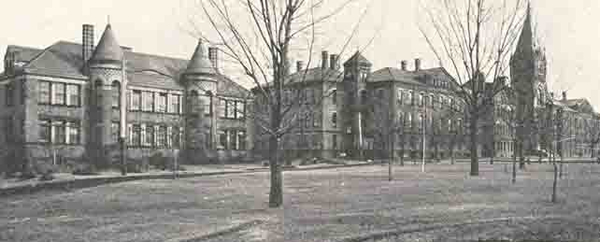 (Photo
origin: IndianaCourts.com; available at
http://www.in.gov/judiciary/citc/cle/eugenics/index.html)
(Photo
origin: IndianaCourts.com; available at
http://www.in.gov/judiciary/citc/cle/eugenics/index.html)
The
Fort Wayne State School for Feeble
Minded Youth
(located on East State
Street in Fort Wayne, initially named the Indiana School for
Feeble-Minded Youth, which opened in 1890), provided the vast majority
of patients for sterilization (around 1,800 out of 2,424 total; Paul
1965, p. 351). However, Stern states the total number of sterilizations
that occurred in the Fort Wayne institution were in fact lower:. just
over 1,500, which was about 75% of the total sterilizations that were
carried out in the state alone (Stern 2005, p. 99). In 1954, due
to dilapidation and overcrowding the location changed to Parker Place
Farm and was renamed the Fort Wayne State Developmental Center. While
the website was active prior to the institution's closing, the Fort
Wayne
facility’s website states nothing of its leading role in sterilizing
Hoosiers. Although it closed in 2007 and the land
given to the Department of Defense, the facility can be considered the
heart of the eugenics movement in the state of Indiana (Muscatatuck).
Jeffersonville State Reformatory
At this
institution in Jeffersonville, it is
believed that Dr. Sharp started preforming vasectomies on "defective”
male inmates as early as October 11 1899 (Quiroz 2008, p. 30).
Different sources put the total sterilizations at the facility from as
low as 175 to about 800 operations. After a fire in 1918, the grounds
were sold to Colgage Company.
 (Photo
origin:
http://idealab.tech.purdue.edu/muscatatuck/mg/building1/view.html)
(Photo
origin:
http://idealab.tech.purdue.edu/muscatatuck/mg/building1/view.html)Other important institutions where sterilizations might have occurred include the Muscatatuck Colony, in Butlerville (Stern 2007, p. 28). The Muscatatuck colony, also known as the Indiana Farm Colony for Feeble-Minded Youth, closed in 2005, due in part to decreasing demand for services for the mentally disabled in Indiana, though there were also allegations of abuse (Rosebrough 2005, p. 1).
Another locale of possible sterilizations (see Stern 2007, p. 28) are the the Logansport State Hospital for the Insane in Logansport and the Indiana Girls’ School, near Indianapolis, which is now a juvenile correctional facility. It appears that the Logansport State Hospital is still in operational (IN.gov, "Other Indiana Hospitals").
There are no official websites or histories for these sites.
Opposition
After only two years of sterilizations with the 1907 law, Hanly’s successor Thomas Marshall, after receiving complaints from people sterilized against their will, decided to issue a moratorium on sterilizations. In 1919 Governor James Goodrich sought to push the law through the court system, resulting in the case heard by the Indiana Supreme Court in 1921, Williams v. Smith. Feeling that the lack of an option of appeal violated the 14th amendment’s due process clause, and that sterilizations were cruel and unusual punishment, the court struck down the sterilization law (Stern 2007, p.12).
Commemoration
In 2007, a marker was erected to commemorate those sterilized under the Indiana Sterilization Act. The marker was erected by the Indiana Historical Bureau, Indiana University, and Indiana University Foundation. The marker number is 49.2007.1 and reads: "By late 1800s, Indiana authorities believed criminality, mental problems, and pauperism were hereditary. Various laws were enacted based on this belief. In 1907, Governor J. Frank Hanly approved first state eugenics law making sterilization mandatory for certain individuals in state custody. Sterilizations halted 1909 by Governor Thomas R. Marshall." On the reverse: "Indiana Supreme Court ruled 1907 law unconstitutional 1921, citing denial of due process under Fourteenth Amendment. A 1927 law provided for appeals in the courts. Approximately 2,500 people in state custody were sterilized. Governor Otis R. Bowen approved repeal of all sterilization laws 1974; by 1977, related restrictive marriage laws repealed."
The exact location of the
marker is 39° 46.185′ N, 86° 9.812′ W. It is located in Indianapolis,
Indiana, in Marion County on North Senate Avenue on the East lawn of
the Indiana State Library: 140 N Senate Ave, Indianapolis, Indiana.
Bibliography
Baldanzi,
Jessica, Bulloff Elizabeth, Dragoo Brent, Fairfield Alicia, Hunter
Claire, and Robbins Kyle. “Eugenics in Indiana.” Available
at <http://www.kobescent.com/eugenics/>,
Bower, M. 2008. “The Historical Marker Database: 1907 Indiana Eugenics
Law.” Available at <http://www.hmdb.org/marker.asp?marker=1829>.
Carlson,
Elof Axel. 2011. "The Hoosier Connection: Compulsory
Sterilization as Moral
Hygiene." In: A Century of Eugenics
in America: From the Indiana
Experiment to the Human Genome Era, ed. Paul Lombardo.
Indianapolis. Indiana University Press,11-26.
Cotton,
Gaylie. 2008. “Logansport Correctional Facility Reactivated
as a Male Juvenile Facility.” State of Indiana. Available at <http://www.in.gov/idoc/files/loganreactiv.pdf>
Deutsch, Nathaniel 2009. Inventing
America's Worst Family: Eugenics, Islam
and the Fall and Rise of the Tribe of Ishmael. Berkeley:
University of California Press.
"Fit to Breed: Eugenics in Indiana." IUPUI : Indiana University-Purdue
University Indianapolis. Web. 28 Mar. 2011. <http://www.iupui.edu/~fit2brd/>.
Image Archive on the American Eugenics Movement. Web. 28 Mar. 2011. <http://www.eugenicsarchive.org>.
IN.gov. “James Frank Hanly”. State of Indiana Available at <http://www.in.gov/gov/2364.htm>.
IN.gov. “Other Indiana Hospitals for the Mentally Ill and
Developmentally Disabled.” Available at <http://www.in.gov/icpr/2671.htm>.
Lantzer, Jason S. 2011. "The Indiana Way of Eugenics: Sterilization
Laws
1907-1974." In: A Century of
Eugenics in America: From the Indiana
Experiment to the Human Genome Era, ed. Paul Lombardo.
Indianapolis: Indiana University Press,
26-45.
Lantzer, Jason S., and Stern, Alexandra
Minna. 2007. “Building a Fit
Society: Indiana's Eugenics Crusaders.” Traces of Indiana and
Midwestern History 19, 1: 4-11.
"Muscatatuck State Hospital Historical District." IDEA Laboratory.
Purdue University. <http://idealab.tech.purdue.edu/muscatatuck>.
Paul, Julius.
1965. “‘Three Generations of Imbeciles Are Enough’: State Eugenic
Sterilization Laws in American Thought and Practice.” Unpublished
manuscript. Washington, D.C.: Walter Reed Army Institute of
Research.
Quiroz, David Alexander 2008. "The Indiana Plan: Dr. Harry Clay Sharp
and the
Eugenic Sterilization of Criminals and Degenerates." Master's Thesis,
Department of History, University
of Houston.
Rosebrough,
Dennis. 2005. “Fort Wayne Developmental Center to
Transition to Community-Based Settings.” Available at <http://www.fwsdc.com/press-release>.
Sharp, Harry. 1907. “Rendering Sterile of Confirmed
Criminals and Mental Defectives.” Proceedings of the Annual
Congress of the National Prison Association: 177-85.
StatsIndiana. 2002. “Historic Census Counts for the U.S.
and States (including District of Columbia) 1900 to 2000.” Indiana
Universityy. Available at <http://www.stats.indiana.edu/population/PopTotals/historic_counts_states.html>.
Stern, Alexandra. 2005. Eugenic Nation: Faults and Frontiers of Better Breeding in Modern America. Berkeley: University of California Press.
Stern, Alexandra M. 2007."We Cannot Make a Silk Purse Out of a Sow’s Ear: Eugenics in the Hoosier Heartland.” Indiana Magazine of History 103: 3-38.
Stern, Alexandra. 2010 "Improving Hoosiers." Indiana Magazine of History 106
(2010): 219-23.